- Table of Content
- 1.Plasmasphere I...
- 2.Become Associa...
- 3.Review of spac...
- 4.PROBA2 Observa...
- 5.Noticeable Sol...
- 6.International ...
- 7.Geomagnetic Ob...
- 8.Review of Iono...
- 9.The SIDC Space...
- 10.Activities at ...
2. Become Associate Editor for JSWSC!
3. Review of space weather
4. PROBA2 Observations (25 Sep 2023 - 1 Oct 2023)
5. Noticeable Solar Events
6. International Sunspot Number by SILSO
7. Geomagnetic Observations in Belgium
8. Review of Ionospheric Activity
9. The SIDC Space Weather Briefing
10. Activities at the STCE
Plasmasphere Ionosphere Thermosphere - PITHIA-NRF news
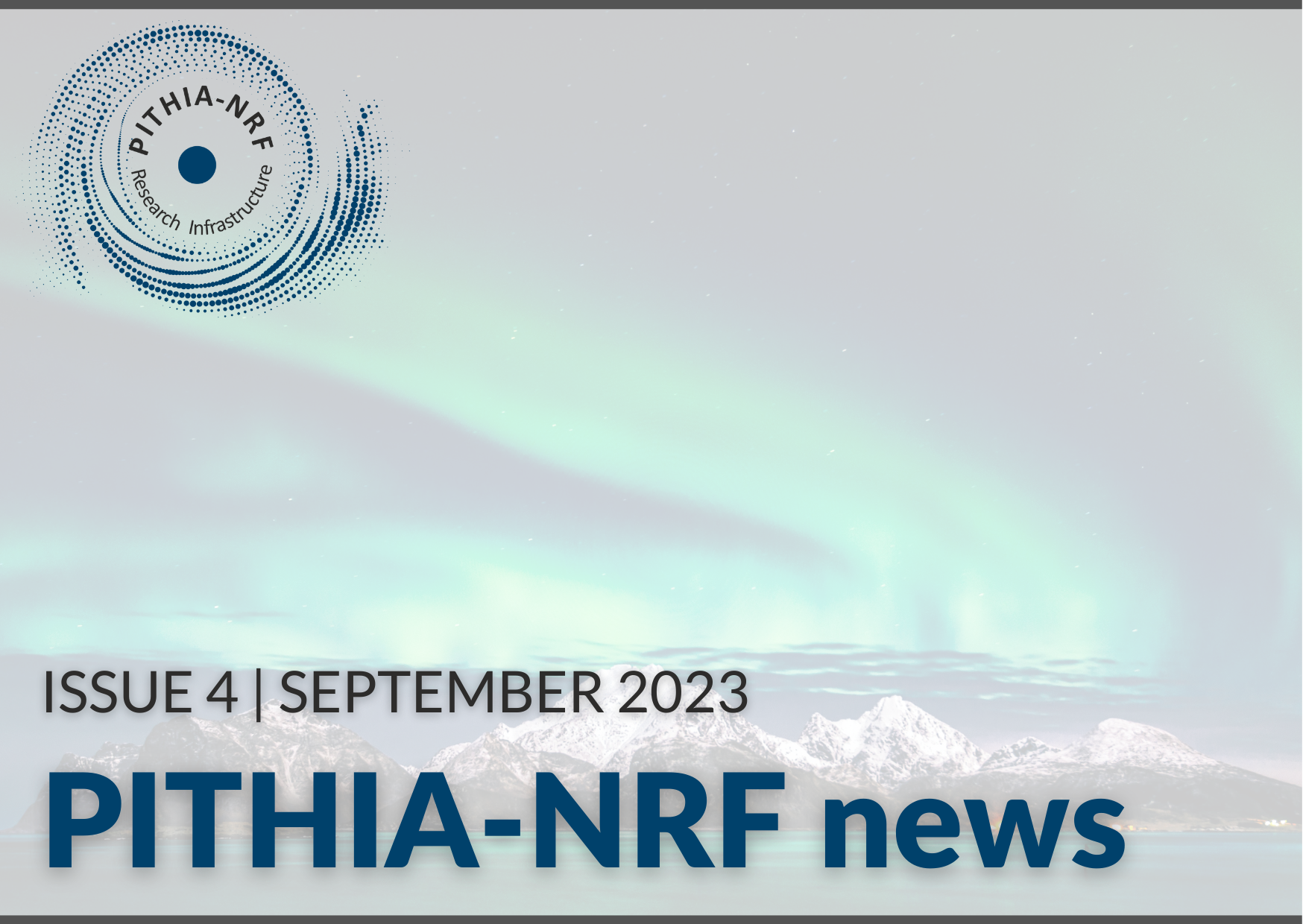
If you are involved in research or services involving the plasmasphere - ionosphere - thermosphere, this newsletter might be of interest.
It includes:
* PITHIA-NRF Training School: building the new generation of Earth's Upper Atmosphere scientists
* Webinars and video lectures available online
* First public release of the e-Science Centre
* 5th Trans National Access call
* Second PITHIA-NRF Training School
Check it out: https://pithia-nrf.eu/pdf/pithia-nrf-newsletter-issue-4.pdf
Become Associate Editor for JSWSC!
The Editors-in-Chief (EiCs) of the Journal for Space Weather and Space Climate (JSWSC - https://www.swsc-journal.org/) are seeking new Associate Editors (AEs) in order to strengthen the Editorial Board. We welcome applications specifically from experts in the physics of the ionosphere-plasmasphere-magnetosphere system, GNSS based research and applications, and machine learning. Applications from experts in other fields in which space weather or space climate play a role will also be considered.
An AE will handle autonomously up to four manuscripts per year in the AE's field of expertise. This includes choosing and inviting reviewers, analysing the reviews, and requesting manuscript revisions as applicable. The handling AE is in charge of the communication between the journal, the author and the reviewers until the final decision which will be taken by the EiCs. An applicant should be aware that JSWSC editorship requires commitment, responsiveness and time to fulfill the assigned tasks. JSWSC editors are not remunerated for their editorial work.
The call will remain open until vacant positions are filled.
For more information or to apply, please send an informal e-mail to one of the EiCs, Natalie Krivova (natalie.at.mps.mpg.de) or Jürgen Watermann (jfwconsult.at.orange.fr). Jürgen, Ilya Usoskin (JSWSC Managing Editor), and several AEs will be present at the E-SWAN booth during the ESWW2023 (https://esww2023.org/), November 2023, Toulouse, and will be happy to talk directly with applicants.
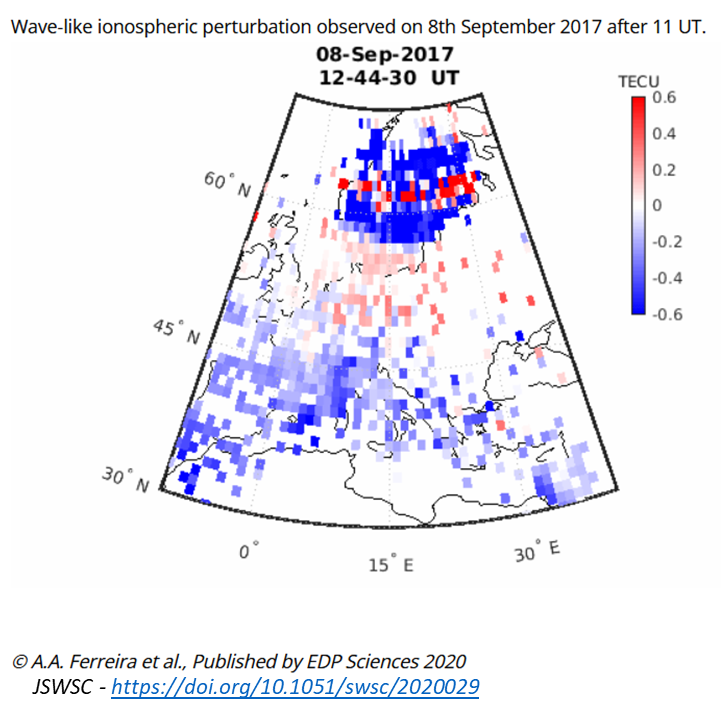
Review of space weather
Solar Active Regions (ARs) and flares
Solar flaring activity was low to moderate. There were 13 active regions visible and 45 C-class flares and 4 M-class flares were recorded by GOES. The largest flare was a M2.5-flare, with peak time 01:32 UTC on October 01 associated with NOAA AR 3451. NOAA AR 3451, NOAA AR 3445 and NOAA AR 3443 produced M-class flares. The other regions showed only low activity.
Coronal mass ejections
No Earth-directed CMEs have been detected. Two filament eruptions were observed in SDO/AIA 304 data on September 25 at 15:48 UTC in the north-west quadrant and 23:21 UTC in the north-west quadrant. Both eruptions were also seen in SDO/AIA 193 but not in LASCO-C2 coronagraph data because of a data gap at the time of the eruptions. No impact on Earth was seen from both of these eruptions in the following days.
Coronal Holes
Three small coronal holes were visible throughout the week. A negative polarity coronal hole was in the north-west quadrant of the visible disk at the start of the week. Two positive coronal holes passed the central meridian on September 29 in the northern hemisphere and on September 30 at the equator.
Solar Proton flux levels near Earth
During the week, the greater than 10 MeV proton flux was at background level.
Electron fluxes at GEO
The greater than 2 MeV electron flux measured by GOES-16 was just below or just crossed the 1000 pfu threshold value. The threshold was crossed once every day between September 27 and September 30. The 24h electron fluence was at nominal levels in the first half of the week while rising and staying at moderate levels during the second part of the week.
Solar wind at L1
From late September 24 to September 26, a magnetic structure was seen in the solar wind data. This might be the result of the interaction between the Sept 21 CME, the Sept 22 CME and a high speed stream. The solar wind reached a max speed of 531 km/s min Bz of -27 nT. After September 26, the solar wind was slow with the interplanetary magnetic field (IMF) varying between 2 nT to 8 nT and the Bz varying between negative and positive values with a minimum value of -8 nT; the solar wind speed varied between 360 km/s and 535 km/s and the phi-angle was mainly in the positive sector (IMF directed away from the Sun).
Geomagnetism
The geomagnetic conditions were at major storm levels globally (Kp 6) and minor storm levels locally (K Bel 5) during to the passage of the magnetic structure on September 24, 25 and 26. The rest of the period was quiet to unsettled.
PROBA2 Observations (25 Sep 2023 - 1 Oct 2023)
Solar Activity
Solar flare activity fluctuated from low to moderate during the week.
In order to view the activity of this week in more detail, we suggest to go to the following website from which all the daily (normal and difference) movies can be accessed: https://proba2.oma.be/ssa
This page also lists the recorded flaring events.
A weekly overview movie can be found here (SWAP week 705). https://proba2.oma.be/swap/data/mpg/movies/weekly_movies/weekly_movie_2023_09_25.mp4
Details about some of this week's events can be found further below.
If any of the linked movies are unavailable they can be found in the P2SC movie repository here https://proba2.oma.be/swap/data/mpg/movies/
Sunday Oct 01
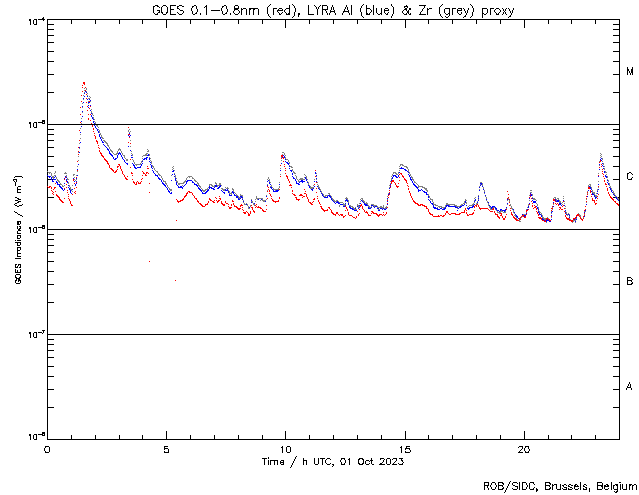
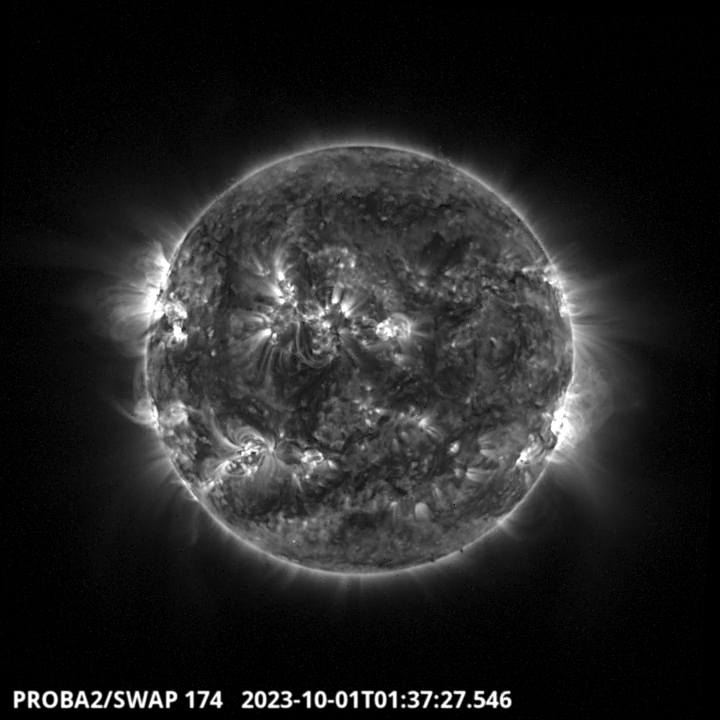
The largest flare of the week, a M2.5 has been produced by the active region NOAA 3452 around 1:37 UT in the North East part of the solar disk. This event is visible on the LYRA and SWAP images above. Find a SWAP movie of the event here. https://proba2.oma.be/swap/data/mpg/movies/20231001_swap_movie.mp4
Noticeable Solar Events
| DAY | BEGIN | MAX | END | LOC | XRAY | OP | 10CM | TYPE | Cat | NOAA |
| 28 | 0858 | 0907 | 0911 | S18E65 | M1.2 | SF | V/3 | 84 | 3450 | |
| 30 | 1616 | 1635 | 1649 | M1.2 | 3451 | |||||
| 01 | 0110 | 0132 | 0143 | M2.5 | III/2 | 3452 |
| LOC: approximate heliographic location | TYPE: radio burst type |
| XRAY: X-ray flare class | Cat: Catania sunspot group number |
| OP: optical flare class | NOAA: NOAA active region number |
| 10CM: peak 10 cm radio flux |
International Sunspot Number by SILSO
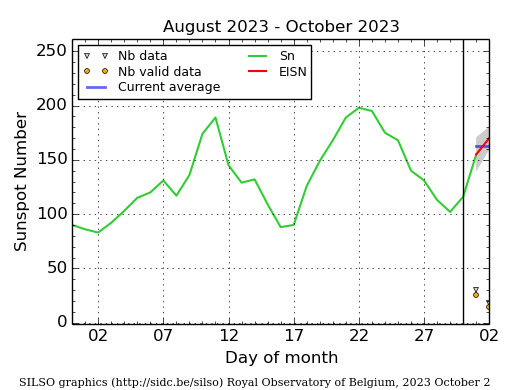
The daily Estimated International Sunspot Number (EISN, red curve with shaded error) derived by a simplified method from real-time data from the worldwide SILSO network. It extends the official Sunspot Number from the full processing of the preceding month (green line), a few days more than one solar rotation. The horizontal blue line shows the current monthly average. The yellow dots give the number of stations that provided valid data. Valid data are used to calculate the EISN. The triangle gives the number of stations providing data. When a triangle and a yellow dot coincide, it means that all the data is used to calculate the EISN of that day.
Geomagnetic Observations in Belgium
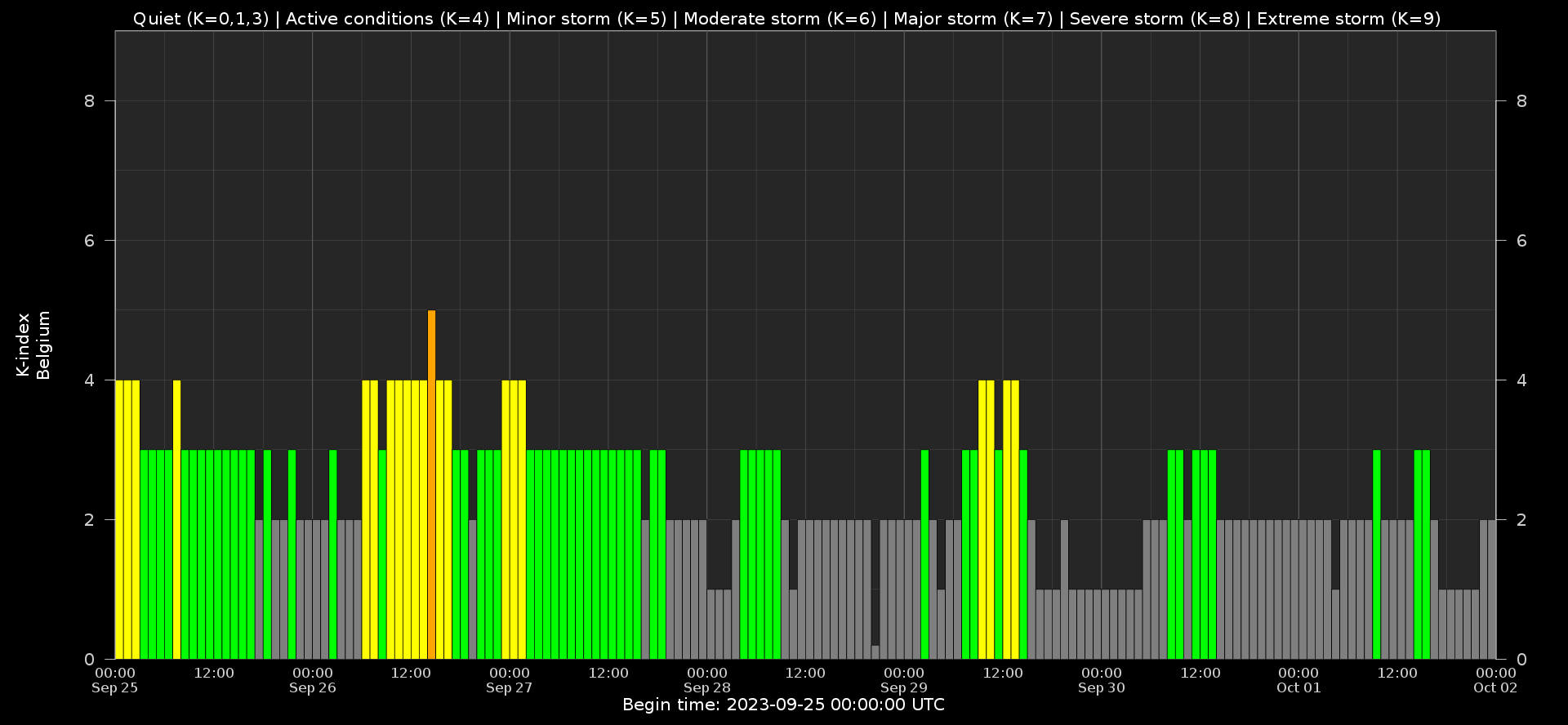
Local K-type magnetic activity index for Belgium based on data from Dourbes (DOU) and Manhay (MAB). Comparing the data from both measurement stations allows to reliably remove outliers from the magnetic data. At the same time the operational service availability is improved: whenever data from one observatory is not available, the single-station index obtained from the other can be used as a fallback system.
Both the two-station index and the single station indices are available here: http://ionosphere.meteo.be/geomagnetism/K_BEL/
Review of Ionospheric Activity
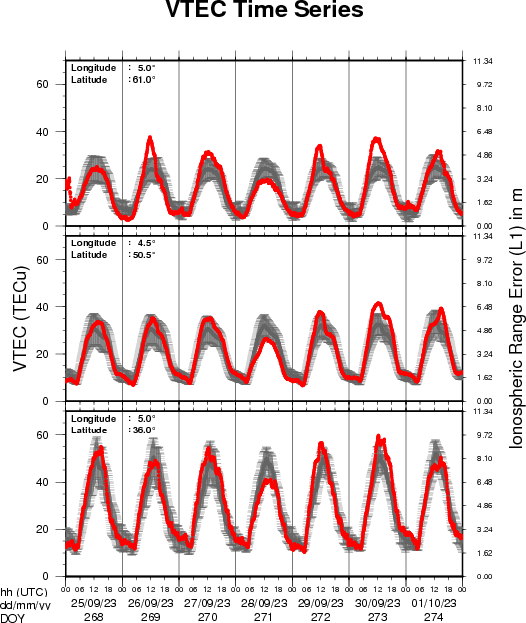
The figure shows the time evolution of the Vertical Total Electron Content (VTEC) (in red) during the last week at three locations:
a) in the northern part of Europe(N 61deg E 5deg)
b) above Brussels(N 50.5deg, E 4.5 deg)
c) in the southern part of Europe(N 36 deg, E 5deg)
This figure also shows (in grey) the normal ionospheric behaviour expected based on the median VTEC from the 15 previous days.
The VTEC is expressed in TECu (with TECu=10^16 electrons per square meter) and is directly related to the signal propagation delay due to the ionosphere (in figure: delay on GPS L1 frequency).
The Sun's radiation ionizes the Earth's upper atmosphere, the ionosphere, located from about 60km to 1000km above the Earth's surface.The ionization process in the ionosphere produces ions and free electrons. These electrons perturb the propagation of the GNSS (Global Navigation Satellite System) signals by inducing a so-called ionospheric delay.
See http://stce.be/newsletter/GNSS_final.pdf for some more explanations ; for detailed information, see http://gnss.be/ionosphere_tutorial.php
The SIDC Space Weather Briefing
The Space Weather Briefing presented by the forecaster on duty from Sept 24 to Oct 1. It reflects in images and graphs what is written in the Solar and Geomagnetic Activity report: https://www.stce.be/briefings/20231002_SWbriefing.pdf
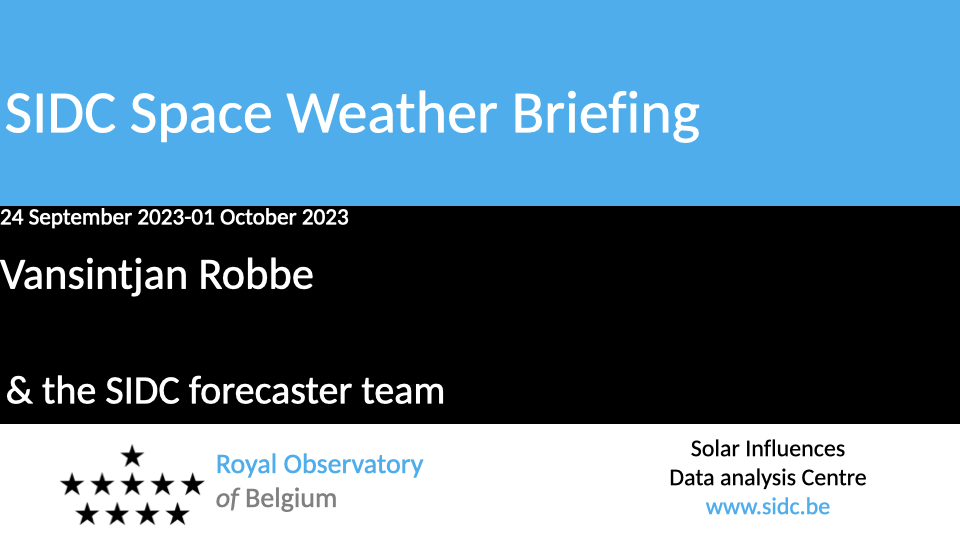
If you need to access the movies, contact us: stce_coordination at stce.be
Activities at the STCE
Check out our activity calendar: activities and encounters with the Sun-Space-Earth system and Space Weather as the main theme. We provide occasions to get submerged in our world through educational, informative and instructive activities.
If you want your event in our calendar, contact us: stce_coordination at stce.be
* Oct 12, E-SWAN Sustainability webinar: Going beyond the “old normal” for a sustainable future in science, online
* Oct 19, E-SWAN Sustainability webinar: The Space Sustainability Paradox - What is space sustainability and how can it be achieved?, online
* Nov 18-19, E-SWAN Space Weather School: data, models and services, by the STCE, Toulouse, France
* Dec 4-6, STCE course: Space Weather impacts on ionospheric wave propagation - focus on GNSS and HF, Brussels, Belgium - Registrations are open
* Jan 22-24, 2024, STCE Space Weather Introductory Course, Brussels, Belgium - Registrations are open
* Jan 25, 2024, post-Space Weather Introductory Course, by JMG and MeteoWing, place TBD - registration is included in the Jan SWIC
Check: https://www.stce.be/calendar
